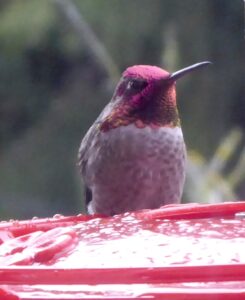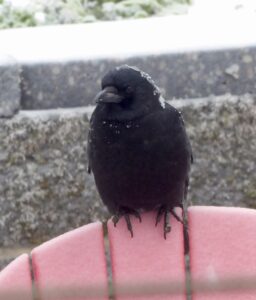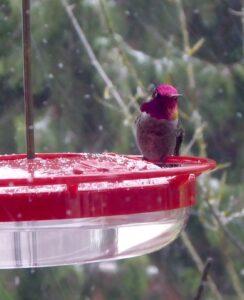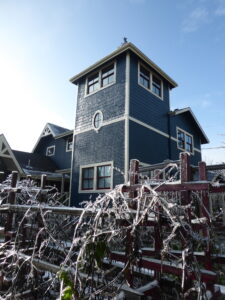 We get plenty of warning that a cold-weather event is on the way. There’s plenty of time to prepare. One can anticipate power outages and stack up containers of drinking water. One can make sure one has batteries and a working flashlight. One can theoretically buy a generator and be the rumbling, roaring envy of the neighborhood.
We get plenty of warning that a cold-weather event is on the way. There’s plenty of time to prepare. One can anticipate power outages and stack up containers of drinking water. One can make sure one has batteries and a working flashlight. One can theoretically buy a generator and be the rumbling, roaring envy of the neighborhood.
I don’t do any of those things. All I think about is how to keep my birds going.
The seed feeders are full but I forgot that my bird bath de-icer broke last year. Still, the birds I’m most concerned about are the hummingbirds. Hummingbirds are energy hogs. They’re going all day long to stay alive and spend the night so metabolically reduced that they’re close to dead. At dawn they light out for the nectar feeders, all dwindly, with their last ember of life, and lore holds that if they don’t get their morning juice they will drop out of the sky and land beak-first in the snow, like fluffy popsicles. I don’t know if it’s so, but I don’t want to risk it.
 I’ve never been a breakfast person myself. I don’t even eat until I’ve been up for a few hours. Clearly my own torrid activity level can be maintained on coffee and air. But I do recognize that we are not all alike, and if hummingbirds are going to be all fuss-and-drama about their breakfast, I need to make sure they don’t need to chip it out of the feeder.
I’ve never been a breakfast person myself. I don’t even eat until I’ve been up for a few hours. Clearly my own torrid activity level can be maintained on coffee and air. But I do recognize that we are not all alike, and if hummingbirds are going to be all fuss-and-drama about their breakfast, I need to make sure they don’t need to chip it out of the feeder.
So in advance of the storm, I got the bright idea to go to a pet store and see if they had anything for their reptiles I could use for my birds. I was thinking about something on the order of an electric brick. I used to have a plug-in electric brick for my iguana, Sparky, but I must have gotten rid of it after we deliberately froze the lizard. That’s another story for another time. Anyway, I can’t find my brick.
 Or maybe they had a heat lamp of some kind. I asked the clerk and she brightly came up with a stack of Reptile Warmers instead, and it seemed like an elegant solution. Reptile warmers, evidently, are what you put in the box if you’re mailing your reptile and you want it to be a fully-operational item when it arrives. They’re just like hand-warmers, but they last forty hours. Yay! I once made a bubble-wrap pocket for a hand-warmer and taped it to the bottom of the hummingbird feeder and it worked great. But it only lasted about eight hours, so I had this whole routine of bringing in the feeder at night after the birds had gone to bed (to die, one wing pressed against their foreheads, the little drama queens), and putting it back out last thing before I went to bed, hoping it would still be warm when the sun came up. Some nights I’d set my alarm for four o’clock to check on it but that kind of takes a lot of the joy out of being retired. If I’m getting up at four, I’d better be going fishing, that’s my motto.
Or maybe they had a heat lamp of some kind. I asked the clerk and she brightly came up with a stack of Reptile Warmers instead, and it seemed like an elegant solution. Reptile warmers, evidently, are what you put in the box if you’re mailing your reptile and you want it to be a fully-operational item when it arrives. They’re just like hand-warmers, but they last forty hours. Yay! I once made a bubble-wrap pocket for a hand-warmer and taped it to the bottom of the hummingbird feeder and it worked great. But it only lasted about eight hours, so I had this whole routine of bringing in the feeder at night after the birds had gone to bed (to die, one wing pressed against their foreheads, the little drama queens), and putting it back out last thing before I went to bed, hoping it would still be warm when the sun came up. Some nights I’d set my alarm for four o’clock to check on it but that kind of takes a lot of the joy out of being retired. If I’m getting up at four, I’d better be going fishing, that’s my motto.
 But a forty-hour warmer! Now we’re talking. Because at fifteen degrees, which was the stupid temperature someone thought we should have for days, I’d need to be swapping out that nectar all day long, too. I bought six of them.
But a forty-hour warmer! Now we’re talking. Because at fifteen degrees, which was the stupid temperature someone thought we should have for days, I’d need to be swapping out that nectar all day long, too. I bought six of them.
I had the first one all shook out and bubble-wrapped and taped to the feeder when I noticed the tiny print in the instructions that said the product “won’t work in temperatures below freezing.” Um? This sort of misses the whole point. I tried it anyway and sure enough that sucker was frozen solid in the morning. It wasn’t even slushy. I pulled in the feeder and put in fresh nectar and watched it freeze within the hour. Clearly I was going to be renewing the thing all day long for days on end. Meanwhile, the bigger birds stood on the bird baths eating snow and looking at me balefully. I took to hollering out the window. “You see all that seed in the feeder? You see that suet? I did that for you! Me!” Then I read that suet freezes too.
Now on top of my lizard fiasco I’m also the worst bird mommy ever and I still haven’t socked away any drinking water for our own consumption.
Come the earthquake? Bug someone else. I’ll be busy sucking up to my prepared neighbors.
We also feed the birds and squirrels all year long. In the warm weather, we hang hummer feeders from hooks on the eave of the house, right outside our windows. In the cold months, we replace the hummer feeders with suet feeders. It’s easy to replace food for them, as all I have to do is open a window. In order to thwart the squirrels, Paul took cymbals from a drum set he no longer uses, and attached them to the top of each feeder.
We also have two squirrel-proof feeders in our yard, and I throw some cracked corn in the back of the driveway for the squirrels. (It has to be CRACKED corn. When I first started this I fed them whole corn… and they planted it all over the yard.)
We keep the bird feed and corn in galvanized trash cans on the side of the driveway, close to the feeders. In order to prevent raccoons and squirrels from opening the cans and getting into the food, we attach key rings to both handles of the cans, attach a length of chain to one, a loop attachment to the chain, and an attachment to the other key ring that can snap onto the loop. So the can lid is secured from marauders. Before we did this, I once went to the can, opened the lid, and I don’t know who was more freaked out — me or the groundhog that had gotten trapped inside the bin. We also keep a weight at the bottom of each can from a weight-lifting set. Before we did this, animals would tip the cans over and seed would spill out for them. So much of feeding the birds entails ways to keep varmints out.
We also dug up an area in our yard that was low-lying and had heavy clay soil. It obviously wanted to be a pond. So we dug it, put down pond liner, got a load of river stones to cover it, and rocks to line the edges, and a few in the pond itself for birds to sit on. We have a fountain to keep the water aerated, and a pond heater when it’s cold out so it doesn’t freeze. We also introduced goldfish to eat the algae. They must eat well, because they get bigger and breed. Occasionally, a few of them will disappear. Raccoons. Some have suggested netting to keep them out, but that would keep out the birds as well, and make it harder to clean the pond filter.
Yes, we are decidedly “for the birds.”
Now I want a varmint. I feel like if I could plausibly use “varmint” in a sentence–just toss it off, you know–that would make me a more interesting person.
Can’t help with the hummingbirds, which leave us in the fall, but I have a wonderful thing sold as a bowl for outside dog runs that plugs in and stays about 40 degrees no matter how cold it is (and it was plenty cold earlier this month). It’s big and white and unattractive but with a couple rocks for perching the birds love it. I got it shipped but evidently feed stores and so on sometimes stock them. The circulating fountain kept open water in another birdbath until it got down into the 20s and at that point packed it in.
Ceci
I brought in my potted aloes that bloom profusely at this time of year (in the desert) because of freeze warnings. I had to put them back out when I saw a female Costa’s hovering around the window looking at the bloom it could see through the glass. We do what we can.
Were you moving them in and out all day?
No. Just for the hard freeze nights. We haven’t had anything like your cold! Lowest it got was 28 or 29. Your efforts are gargantuan.
I had to stop putting out birdseed because of the rats.
I’ve got three small metal trash cans and a full size metal trash can with rodent proof lids. The lid fits down tight over the can and the handles of the smaller cans pull up and lock it in place. A raccoon might be able to open them, but first they’d need to get into my shed.
There are very few overwintering hummingbirds in NJ and they mostly hang out in Cape May.
We have rats around here, for sure, but they don’t seem to get into the bird seed. I think that’s because we have two Mexican restaurants at the end of the street and that’s where they’d rather hang out.
The rats in my yard seem to prefer meat, but will settle for seeds. I set peanut butter baited rat traps that caught a mouse. Which the rats then ate.
Murr, they sell heated hummingbird feeders at Backyard Bird Shop. They sold out in the storm. My neighbor bought one online. They run on electricity so if your power goes out, you’re stuck. Unless, that is, you buy that generator…
I do know that but they had sold out before I was able to get there. I really thought I had it covered with the reptile warmers. Anyone want some reptile warmers?
We also use electric heaters that fit on the bottom of a standard hummingbird feeder. And we use portable lights with incandescent bulbs that we hang a few inches from the feeder. When the temperature gets really cold, we bring one feeder in overnight to warm it up, then place it back outside at sunrise. That works well. We use three feeders, so the hummers always have at least one to go to.
Backyard Birf Shop and likely Portland Audubon sell hummingbird feeder warmers. By them now for next year. They last a long time.
Oh I will. Of course that’s the problem though–you have to have power. I think I’ll have to lay in a stock of hand warmers just in case we lose power. Which, for some reason, we rarely do here. We’ve been really lucky in that regard.
“Fluffy popsicles”…Now, that’s a word combo I don’t think I’ve ever read before.!
My specialty!
You bought six without reading the fineprint? Oy!
I get your concern, those birds are tiny and cute, but they survive the winters somehow in places where nobody feeds them.
The issue is that changing climate patterns can strand birds in places where they normally wouldn’t have remained. In recent years there have been ruby throats overwintering in NJ, perhaps lulled by longer growing seasons and milder falls and winters. But if we get a sudden cold snap, they’re in trouble.
Bruce
Lulled too by the artificially man-supplied source of food year ’round. This phenomenon has been observed for years.
Carolyn
Could be so for ruby-throats, but Anna’s hummingbirds have had a winter population in the Pacific Northwest for a long time. The range has crept north with some of their nectar sources. Their nighttime torpor is a key to their survival here. I do not know if other hummingbirds do that to the same extent. Anyone?
Yes, river, without reading the fine print. It was VERY fine print, and the woman at the pet store specifically offered them for the purpose, so I didn’t question it, especially because the hand-warmers worked pretty well.
Feeding the birds seems to me to be something good we can do to offset the total destruction of their habitats due to farming, logging, paving, etc. for which we are responsible.
One of the saddest books I’ve read is “The Race to Save the Lord God Bird” — a detailed account of how humans drove the ivory billed woodpecker to extinction, knew we were doing it while we were doing it, and continued to do it.
The Good Lord Bird by James McBride was one of my favorite reads. It was a fiction based on fact. It concerned an escaped slave, Henry Shackleford, who was pre-pubescent, and looked vaguely feminine, so he played the part and joined up with John Brown and the Abolitionists. Also a TV mini-series made of the book — and stayed true to it — with Ethan Hawke doing a great job as John Brown.
I know this book has nothing to do with the extinction of the Ivory Billed Woodpecker — which plays a peripheral part in the story — but it was one of those books I couldn’t put down. And I’m tired of being depressed and angry. I had enough of that lately.
Am I still anonymous, even with a photo and email? FYI, I’m me!
Good Lord Bird— wonderful on Audible. How do I find it as a mini series???
Netflix. I can’t remember if we watched it on streaming, or on dvd (back when Netflix still did dvds.) Now when I want a certain dvd, I order it from the library.
I don’t know the book, but I sure do know the story of the Good Lord Bird.
Here in DC, the rats are famous for chewing through the city-issued heavy plastic trash cans…..so I’m afraid that they would probably consume all of the seed & suet & nectar and then start chomping down any bird feeder…